|
|
| Vintage Hockey Autographs, Autographed Memorabilia, Page 4
|
|
|
| Bill
Durnan, Montreal Canadiens (HOF) goalie autographed business
card |
 |
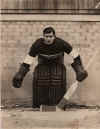
|
Bill Durnan
packed an entire career's worth of awards and recognition into
his seven National Hockey League seasons with the Montreal
Canadiens from 1943 until 1950. He won the Vezina Trophy as the
league's top netminder an amazing six times, missing out on the
award only once to Toronto's Turk Broda in 1948. He won the
Vezina Trophy for his first four consecutive seasons and First
All-Star Team honors. 1947-48 was the only time, he didn't lead
the league in goals -against average and Montreal missed the
playoffs. Broda, with the powerhouse Maple Leafs, took Durnan's
spot on the First All-Star Team and had his name engraved on the
Vezina Trophy as well as the Stanley Cup. Durnan returned to his
winning ways in 1948-49, setting a modern league record with a
shutout streak that lasted over 309 minutes and four games. In
the next two seasons he was once again the best goalie in the
league. However in 1950 Durnan's nerves were shot from all the
physical and mental stress - from all the playing time - and he
retired from the game at 35
His NHL career stats are as follows:
383 games played - 208 wins - 112 losses
2.36 goals against average - 34 shutouts
Won Vezina trophy - 1944, 1945, 1946, 1947, 1949 and 1950
NHL All-Star -1944, 1945, 1946, 1947, 1949 and
1950 |
| Ace Bailey,
Maple Leafs Great, signed 4x6 sheet and hockey
puck |
 |

|
Irvine "Ace"
Bailey was one of the most popular Leafs players during his few
years in the NHL, but he will forever be linked to one of the
worst on-ice accidents in the history of the game. His career was
tragically cut short on Dec. 12, 1933 when he was hit from behind
by Eddie Shore of the Boston Bruins, suffering a fractured skull
which ended his career as a player. Prior to the incident, Bailey
was regarded as one of the great goal scorers of the game and a
top defensive forward. Ace lead the NHL in goals and points in
1928-29.
The NHL's first All-Star game on Febuary 14, 1934 was played to
benefit Bailey and his family.
His NHL career stats are as follows:
313 games played - 111 goals - 82 assists
NHL scoring leader 1929 |
| Herb
Gardiner, Montreal Canadiens (HOF) Great, autographed
letter |
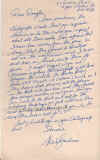
|
The letter
states the following: Dear Douglas, I am enclosing the
autograph cards that you requested. However as to the rest of
your request about old team mates, I am afraid that I have been
away from the game so long, that they would be scattered all over
the continent and I have not been in touch with them for years. I
might suggest if you are desirious of getting the autographs of
the old time players to write to the Hockey hall of Fame C.N.C.
Toronto 2B Ontario, Canada, and they have a book showing all the
players in the hall with pictures and there records. There
present address is not given but you can write to the Hall and
ask for the address of the players you pick out and they will
gladly send them on to you. By the way the book is sold for
$2.00.
Best luck to you in your autograph hunt.
Sincerely, Herb Gardiner
A stellar two-way defenseman, Herb Gardiner didn't make a name
for himself until relatively late in his career. He was
proficient at the amateur level in western Canada before
traveling east to play in the NHL. Gardiner was a rock on the
defense corps of every team he played on, and he was also
respected for his consistent play through each season. During the
late 1920s, he formed one of hockey's most successful defensive
duos with Sylvio Mantha.
Gardiner turned professional in 1921-22 with the Calgary Tigers
of the newly created Western Canada Hockey League, where he spent
five long but rewarding seasons. He enjoyed his greatest success
partnered with future NHLer and league president Red Dutton on
defense. In 1924 Gardiner helped the Tigers gain the WCHL crown
in a tough series versus Regina. He and Dutton provided stellar
work in their own end against the likes of superstars George Hay,
Dick Irvin and Barney Stanley. Gardiner scored a key goal in the
first match at Regina, which ended in a 2-2 deadlock. The Tigers
clinched the total-goals series with a 2-0 win on home ice.
Following this achievement, the Tigers ventured east with the
Pacific Coast Hockey Association champion Vancouver Maroons to
confront the Montreal Canadiens. Calgary and Montreal disposed of
Vancouver, setting up a final in which the Canadiens proved to be
too strong. Matched against the speed of Howie Morenz and Aurel
Joliat, the Tigers lost 6-1. Despite the Tigers' setback,
Gardiner made a strong impression on the Montreal management. The
most notable feature of the contest from a Calgary perspective
was that defensemen Dutton and Gardiner gave no ground to Sprague
Cleghorn and Billy Coutu on the winning side.
The following year Calgary succumbed in the Western championships
to the Victoria squad that went on to defeat the Canadiens and
become the last non-NHL team to win the Stanley Cup. Gardiner was
solid once again for the Tigers, but the Cougars were led by
superb performances by Frank Frederickson, Jack Walker and
netminder Harry Hap Holmes.
Recalling his excellent play two years earlier, the Canadiens
invited Gardiner to training camp in 1926. The experienced
defender represented a vital addition to the Montreal defensive
brigade when he joined the team that year. His play was so
impressive with the rebuilding Montreal franchise that he was
awarded the Hart Trophy as league MVP - no small achievement, as
he beat out New York Rangers superstar Bill Cook to cop the
award. During this time, he formed one the NHL's most proficient
duos on defense with Sylvio Mantha.
Gardiner was loaned to the Chicago Black Hawks in 1928-29 but was
recalled by the Canadiens for the post-season. The following year
he was sold to the Boston Bruins, who moved him to the
Philadelphia Arrows of the Canadian-American Hockey League as
playing coach.
Gardiner adapted well to the additional responsibilities coaching
entailed. He remained with the Arrows until 1935-36 before
joining Philadelphia's American Hockey League franchise, the
Ramblers. Gardiner coached this team to the Calder Cup finals in
1937 and 1939. He concluded his coaching endeavors with the
Philadelphia Falcons of the Eastern Hockey League from 1944 to
1946. In 1947 he was named general manager of the Philadelphia
Maroons, a proposed NHL franchise that was never realized. As
both a defenseman and coach, Gardiner always put his keen
understanding of the game to excellent use. He was elected to the
Hockey Hall of Fame in 1958. |
| Cyclone
Taylor, Hockey Legend, autographed hockey photo |
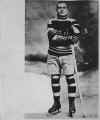
|
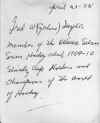
|
This matte
photo has been signed on the rear by Cyclone Taylor along with
the following notation:
April 21, 1975
Fred W (Cyclone) Taylor
Member of the Ottawa Silver Seven Hockey Club 1909-10 Stanley
Cup Holders and Champions of the world of hockey
Frederick Wellington Taylor performed exceptionally well at
several positions during his legendary career. His dynamic rushes
and memorable scoring feats made him one of hockey's first
superstars. He was one of the few players in the history of the
game capable of skating backwards as fast as many could
forwards.
Born in the village of Tara, Ontario, Taylor grew up in nearby
Listowel, which is where he first took up hockey as well as
lacrosse and soccer. Taylor exhibited promise for the first time
as a member of the Listowel Mintos and Queen's Own before
graduating to the city's top junior club in the OHA. He played
with the Listowel juniors from 1903 to 1905 before leaving the
province to broaden his horizons. Taylor jumped at the chance to
play for the Portage La Prairie team of the Manitoba Senior
Hockey League in 1905.
Before the end of the 1905-06 season, he was signed by the
Houghton, Michigan, Portage Lakers franchise of the International
Hockey League. Based in northern Michigan, this was the first
professional circuit in North America. Taylor joined his new team
in time for only the last six games of the season, but the
"Listowel Wonder" wasted little time in making an impact. He took
the league by storm, scoring 11 goals in the half-dozen matches
and garnering a place on the IHL All-Star Team. The following
year, Taylor was a major component of the Houghton club's league
championship.
In 1907-08, Taylor joined the Ottawa Silver Seven of the Eastern
Canada Amateur Hockey Association. It was here that he made a
name for himself as an explosive rushing defenseman, scoring nine
goals in 10 games. The nickname "Cyclone" was first accorded this
exciting figure by local reporters after a cartoonist with the
Ottawa Journal depicted one of his cyclonic rushes in vivid
detail.
Taylor's excellent play helped Ottawa win the ECAHA championship
in 1909 and the team became holders of the Stanley Cup. In a
transaction that caused a stir across Canada, Taylor was signed
in 1910 by the Renfrew Millionaires franchise, which was
preparing to join the newly founded National Hockey Association
in 1910. The salary paid to him was the highest ever for a
Canadian athlete up to that time and remained so for many years.
Taylor scored 22 goals in 28 games over the next two seasons
before the team was disbanded.
When Taylor couldn't reach a satisfactory agreement to stay in
the NHA, the Vancouver Millionaires of the Pacific Coast Hockey
Association moved quickly to offer him a contract. Team manager
Frank Patrick decided to switch Cyclone to the forward position,
and there he thrived from 1913 to 1921.
While employed on the West Coast, Taylor averaged more than a
goal per game in a formidable display of offensive prowess. His
second Stanley Cup triumph came in 1915. He scored six goals in
the Millionaires' three-game domination of Ottawa in the
championship showdown. The sheer magnitude of Taylor's excellence
in the series elevated him to the status of hero right across
Canada.
Taylor led all PCHA goal scorers in 1918 and 1919 with 32 and 23
goals respectively. Even though the Toronto Arenas defeated
Vancouver in the 1918 Stanley Cup championship, Taylor proved to
be the most revered performer in the match-up. He finished ahead
of all playoff scorers with nine goals in seven games.
Cyclone retired following the 1920-21 schedule but delighted the
fans one more time by making a one-game cameo appearance for
Vancouver two years later. He accumulated 194 goals in 186
regular-season games while carving out a reputation as one of
hockey's surefire drawing cards. He earned the remarkable
distinction of being named to the First All-Star Team everywhere
he played from 1900 to 1918.
Taylor's sharp hockey mind led to his being named president of
the Pacific Coast Hockey League in 1937. An active member of the
Vancouver community, he helped form the British Columbia Hockey
Benevolent Society, where he served as director from 1954 until
his death in 1979.
Cyclone was voted into the Canadian Sports Hall of Fame and the
British Columbia Sports Hall of Fame. He was elected as a charter
member of the Hockey Hall of Fame in 1945, and he was also given
the honour of turning the sod for the construction of the Hockey
Hall of Fame building that opened in 1961. |
| 1938
Montreal Canadiens vs Detroit Red Wings program autographed by Babe Siebert and others |
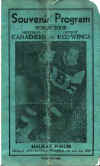
|

|
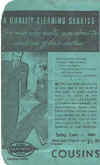
|
This program
is for two games that were played April 8 & 9, 1938 at the
Halifax Forum. Inside (see middle photo) it has been signed in
pencil by Babe Siebert (upper left), Walter Buswell (lower left),
Pit LePine and Normie Smith (upper right). The autograph that
makes this so special is that it is signed by Babe Siebert who
would tragically die in a drowning accident a littler over a year
later (8/25/1939)
Babe Siebert entered the NHL with the Montreal Maroons in 1925-26
and almost immediately became part of the famous S Line that also
featured Hooley Smith and Nels Stewart. In that first year the
team finished second to Ottawa in the standings but beat the
Senators in the playoffs and then finished off Victoria, the PCHL
champs, to win the Stanley Cup. The S Line was the most feared
line in hockey until 1932, when Siebert was traded to the
Rangers. Although the line won no more Cup championships after
that first year together, the three were consistently near the
top of the league in scoring. Stewart was the natural scorer on
the line, and Smith was the passer, but Siebert was equally well
known for his rushing, his sheer physical strength and his
relentless backchecking to get the team possession of the puck.
In New York, Siebert won his second Stanley Cup in 1933 when the
Blueshirts defeated Toronto three games to one in the
best-of-five finals. He was traded to Boston midway through the
following season, but in 1936 Cecil Hart became coach of the
Canadiens and insisted the club reacquire Howie Morenz and pick
up Siebert. And so, in the twilight of his career, Babe returned
to Montreal. His speed was gone, so Hart wisely put him back on
defense, where he was just as effective as ever. In his first
year with the Canadiens, he won the Hart Trophy. After the
1938-39 season, he retired, and just a few weeks later he was
named the new coach of the Canadiens. Tragedy struck, however, on
August 25, 1939, when he drowned at the family resort. The hockey
world was shocked by the loss of Siebert, and the NHL arranged a
memorial game at the Forum, with the proceeds going to his wife.
It was the third such game in league history - the first, in
1934, had been for Ace Bailey after his career was ended by an
Eddie Shore hit; the second, for the family of Howie Morenz, was
held in 1937 - and these were the forerunners to the All-Star
Game which became an annual fixture starting in 1947. The Siebert
game raised more than $15,000 for his family even though
attendance was surprisingly weak at just 6,000. Siebert was
posthumously inducted into the Hockey Hall of Fame in
1964. |
| Ching
Johnson, New York Ranger Great, autographed index
card |
 |
Defenseman Ivan (Ching)
Johnson was the number one fan favorite of the Original Rangers.
He played in the Rangers first game on November 16, 1926
(a 1-0 victory over the Montreal Maroons) and stayed with the
club for 11 seasons. He ended his Blueshirt career on March 21,
1937 (a 3-1 win over the Montreal Canadiens).
During his years with the Rangers, Johnson built himself into a
permanent New York City legend. His fearless style and
straight-down-the-middle one man rushes on enemy goalies were
something to behold. To be sure, teammates Bill Cook and Frank
Boucher were better players, but Johnson was the unmistakable
god of the galleries. He was also a member of the
1927-28 and 1932-33 Stanley Cup championship clubs.
Johnson was always a mischievous sort. One of his favorite
tricks was to hide a puck in his gloves, hardly an easy task
given the tight-fitting equipment of the day. Then, during a
multi-player scrum along the boards, Ching would release the
second puck, causing an immediate whistle and more than a little
confusion, not to mention a breather for the wide-grinning
defenseman. “I only did it four, maybe five times, but it
was great fun,” Johnson said. “I even used to do it
in practice, but that was tough because Lester (Patrick) used to
count the pucks, no foolin.”
Johnson’s nickname – the fans would shout
Ching, Ching Chinaman – had nothing to do
with his ethnicicity (actually he was of Irish descent). It
derived instead from summer camping trips Johnson and his pals
would take along the Red River in Alberta. It was common practice
on week-long excursions of this sort to hire a man, usually of
Chinese descent, to serve as the group’s cook. Johnson
would regularly volunteer for the duty, probably to save money,
and the unseemly nickname was born.
Following his retirement from the Rangers, Johnson decided to
play one more season with the rival New York Americans. The
Rangers played the Americans six times that season, but injuries
limited Johnson to just 31 games. He faced his old team in four
of the six games, losing three and tying one. How popular was
Ching Johnson? Prior to his first game with the Americans, the
Rangers’ fans presented their newest rival with a gold
watch at center ice of Madison Square Garden.
In 403 career games with the Rangers,
Johnson tallied 38 goals and 48 assists for 86 points, along with
798 penalty minutes. He was elected to the Hockey Hall of Fame in
1958. |
| Cecil "Ceece" Dillon
autographed index card |
 |
Cecil Dillon had an
eleven-year NHL career spanning the years from 1931 to 1942. From
1928 to 1931, Dillon skated for the Springfield Indians of the
CAHL. Midway through the 1930-31 season Dillon joined the New
York Rangers for 25 games where he scored seven goals and three
assists.
In 1931-32 Dillon played a full 48-game season with the Rangers
scoring 23 goals and 15 assists for 38 points. In fact, Dillon
was a model of consistency, not missing a single game in eight
years. In 1932-33 Dillon was a member of the Rangers team that
won the Stanley Cup with Lester Patrick coaching.
Dillon scored at least 20 goals in five of his eleven NHL
seasons. In 1939-40 he played his final NHL season as a member of
the Detroit Red Wings, playing in 44 games, scoring seven goals
and ten assists.
He played another two years of professional hockey before
retiring. In 1940-41, he played 49 games with Indianapolis of the
AHL and 51 games with the Pittsburgh Hornets of the AHL in
1941-42, collecting 13 goals and 23 assists. |
| Murray "Muzz" Patrick
autographed index card |
 |
In his youth, Muzz Patrick
was one of Canada's most versatile athletes, excelling in track,
basketball, football, cycling, boxing and hockey. In the ring, he
was a Canadian amateur light heavyweight champion. But having
Lester Patrick, the original coach and GM of the New York
Rangers, for a father, lent a heavy bias towards pursuing hockey
as a career.
Patrick turned pro with the New York Crescents in 1934 and then
jumped to the Rovers the next year. There he played with future
NHLers Alex Shibicky and the Colville brothers, Neil and Mac.
After a two-year stint with the Philadelphia Ramblers of the AHL,
Patrick finally settled in for full-time NHL action in 1938 with
the Rangers. It was there that he used his large frame and boxing
skills to keep opponents honest in the Rangers' zone. One night,
Patrick's prowess came into full view when Hall of Famer Eddie
Shore massaged the neck of the Rangers' Phil Watson while against
the fence. Patrick intervened by dropping his gloves and, after a
vigourous tilt, left Shore with a broken nose among other swollen
souvenirs.
At the close of his second full season on Broadway in 1939-40,
Patrick got his ultimate reward with a Stanley Cup victory?the
last the Rangers would enjoy until 1994. With the outbreak of
World War II, Patrick was one of the first NHLers to enlist in
the U.S. Army just before the bombing of Pearl Harbor.
After the war, he returned to the Rangers for 24 games before
heading to the minors where he ended his on-ice career with the
Tacoma Rockets in 1949. Patrick then placed his full-time focus
on coaching?a career he'd already started with Tacoma in 1947-48.
After the Rockets disbanded, he moved over to the WHL's Seattle
Bombers where served as the team's manager and coach.
In 1954, he made a return to New York where he coached the
Rangers for a season before becoming the club's GM, a post he
held until 1964. |
| Ebbie Goodfellow,
Detroit Red Wings (HOF) player, autographed index
card |
 |
Born in Ottawa, Ontario in
1907 Ebbie joined the Detroit Cougers (later renamed Falcons and
finally Red Wings) in 1929 and stayed with Detroit for 15
seasons. Originally property of the New York Americans, Detroit
traded Johnny Sheppard and $12,500 to get the high scoring 6'0"
175lb scoring machine. In an era before Gordie Howe, Goodfellow
was considered to be Detroit's most illustrious hockey performer
during the 1930s.
Originally a center, he became one of the league's top scorers.
He scored a career high 25 goals and 48 points in 44 games in
1930-31. Although he was a high scoring forward, he was shifted
to defense by coach Jack Adams after he began to lose a little
speed. The gamble paid off for Adams as Goodfellow became one of
the best defensemen in the league and remained a consistent
scorer as well. He led the Wings to the Stanley Cup in 1936 and
1937, when he was named an all-star defenseman in 1937 and 1940.
He also becam e the first Detroit player to win the Hart Trophy,
as in 1940 he was honored as the league's most valuable
player.
Playing hockey back then didn't make the players rich.
Goodfellow kept his day job as a tool and die salesman and was a
playing coach for the Wings in 1941 and '42.
He played a few games in 1943, ending his hockey career as a
Wing. With 324 points in 556 regular games he was inducted into
the Hall of Fame in 1963. He died in 1985 at age 78. |
| Joe Primeau, Maple
Leafs Great, autographed index card |

|
Primeau developed his
hockey skills late in life when compared to his counterparts. It
wasn't until the age of 12 that he began skating, but despite
this, Joe's resolve to make the pro's helped him to develop his
hockey skills quickly. In just 6 short years after donning his
first pair of skates, Joe was playing for the Toronto St.
Michael's Majors of the OHA. The St. Mike's as they were better
known, contributed many players not only to the Toronto Maple
Leafs, but to other NHL clubs as well.
His first season with the club, 1923-24 would be by the record
books a slow season for Joe as he had 1 goal and 1 assist in 6
games. He improved these numbers in his second season when he
went to the Toronto St. Mary's, also in the OHA, and notched 7
goals and 3 assists in 8 games. In 1925-26 Joe started to find
himself and led the OHA with 15 goals, added 2 assists, which
gave him the lead in the league for most points with 17.
The Toronto Marlboros of the OHA Sr. loop was the next stop for
Primeau in 1926-27 where he popped 11 goals and 3 assists for 14
points in 11 games. At the same time in New York, Conn Smythe was
in the process of putting together the New York Rangers and he
remembered Primeau, recommending that the Rangers sign him. The
Ranger's organization was reluctant to sign a player of Primeau's
size and passed on the recommendation.
Shortly thereafter, Smythe was relieved of his duties with the
Rangers and promptly proceeded to Toronto and purchased the
Toronto St. Patricks and renamed them the Toronto Maple Leafs.
One of his first moves was to sign Joe Primeau and did so on July
17, 1928. Joe made a few brief appearances with the Leafs in
1927-28 and 1928-29 but in 8 games he managed only a single
assist.
The 1929-30 season was Joe's first complete NHL season with the
Leafs and it proved to be a good one, and it was the first season
that Primeau's play making ability would shine through. Never
again would his goal total exceed his assist total. Sometime in
1930, Smythe teamed up Primeau with Harvey "Busher" Jackson and
Charlie "the Big Bomber" Conacher to form the "Kid Line." They
got their name because all 3 were inexperienced youngsters, but
despite their youth, they became the most famous Toronto line of
all time.
Primeau led the league in assists in 1930-31 with 32, and later
repeated the feat in 1931-32 and 1933-34 with 37 and 32
respectively. The pinnacle of Joe's career came in 1931-32 when
he tallied 50 points on 13 goals and 37 assists, finishing a mere
3 points behind his team mate Jackson for the league scoring
title. That same season, the Leafs took the Stanley Cup with Joe
again leading the league in assists during the playoffs with 6 in
7 games. Joe again finished second in the scoring race in 1933-34
with 46 points, this time 6 points behind his other line mate,
Charlie Conacher who finished the season with 52 points.
The following season Joe broke his thumb in a pre-season
exhibition game, causing him to miss 11 games, and that spelled
the end of the "Kid Line." Joe retired at the end of the next
season to devote more time to his construction business,
finishing up his career with 66 goals, 177 assists for 243 points
in 310 regular season games.
By 1938-39 Joe was back in hockey as coach of the Toronto
Marlboro's Senior team, and also coached the Toronto RCAF
Hurricanes in 1942-43. Primeau returned to the St. Michael's
organization and in 1944-45 and in 1945-46 he coached them to
Memorial Cup victories. After joining the Marlie's Senior team,
he guided them to the Allan Cup Championship in 1949-50. He was
then hired by the Toronto Maple Leafs and took them to a Stanley
Cup victory in 1950-51. This "Triple Crown" of the Memorial,
Allan and Stanley Cup Championships made Joe the first and only
coach in hockey history to accomplish such a feat.
In all, Joe Primeau won the Lady Byng Trophy in 1932, was named
to the NHL Second All Star Team in 1934 and played in the NHL All
Star Game in 1934. Joe was voted into the Hockey Hall of Fame in
1963. |
| Home | Hockey Autographs - Page 5
|
copyrightŠ2000-2008
All hockey memorabilia and their images are the exclusive property of the owner and may not be reprinted, copied or used without written permission from the owner. For licensing or other questions please contact hockeybum@proaxis.com
|
 |
|

